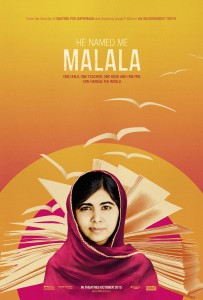 I first knew of Malala Yousafzai when she appeared on “The Daily Show” in 2013 and completely humbled Jon Stewart. She talked of what she would do if the Taliban did in fact come for her, saying she would opt for peace instead of hitting the man with her shoe. She got a laugh from the line, but she admitted if she had done that she’d be no better than the Taliban. Stewart leaned back, put his hands over his mouth in stunned disbelief at the person he was talking to and the story he was hearing. He exhaled deeply and asked if he could adopt her. “You sure are swell”.
I first knew of Malala Yousafzai when she appeared on “The Daily Show” in 2013 and completely humbled Jon Stewart. She talked of what she would do if the Taliban did in fact come for her, saying she would opt for peace instead of hitting the man with her shoe. She got a laugh from the line, but she admitted if she had done that she’d be no better than the Taliban. Stewart leaned back, put his hands over his mouth in stunned disbelief at the person he was talking to and the story he was hearing. He exhaled deeply and asked if he could adopt her. “You sure are swell”.
Malala is swell, not only an inspirational survivor but a young, adorable charmer capable of doing a magic trick on a late night talk show and then bringing the audience to their knees with her thoughts on women’s rights for education. Getting an intimate look at her would be ideal in a documentary, not least in a Davis Guggenheim documentary. Guggenheim’s docs are the best at being entertaining and heartwarming, and his last feature documentary “Waiting for Superman” even tackled the failing American education system.
“He Named Me Malala” however is only interested in just how swell Malala can be. Guggenheim is more interested in seeing what she got on her high school physics test than in seeing what she believes. His film is plenty cute and crowd pleasing, but also horribly cloying and hardly worthy of the substance Malala has brought to the global stage.
When Malala was just 14 she began speaking out against the Taliban in her hometown of Swat in Pakistan. The Taliban blew up schools in the name of Islam and denied women basic privileges to shop, to dance, to educate themselves. Malala took a stand and was shot for her words. She barely survived but has since left Pakistan and taken her story and her message abroad. Malala became the youngest Noble Peace Prize nominee in 2013 and won it the following year.
Guggenheim takes us step by step through how Malala was shot and how she recovered. We see X-rays of her skull, we see a diagram of the bus she was riding on, and we see graphic photos of blood on the seat where she sat. Is this even remotely necessary?
Guggenheim’s obsession with these tear jerking details show how misplaced his priorities are, not to mention his film’s tone. He can go from a light-hearted scene of wondering if Malala would ever ask out a boy to talking about a beheading. It spends so much time vilifying the Taliban, as if American audiences needed to be anymore convinced.
“He Named Me Malala” takes us through Malala’s childhood, what she thinks of her classes in London, her fame, her polarizing stature back home, and most of all her endearing family life. Malala’s two brothers are perfectly cute, and they speak of their older sister like any boy would. Guggenheim even shows Malala and her brothers arm wrestling, as if to say that Malala is strong mentally and physically.
These moments however dominate a film that would be better suited revolving around her passion for education. Watch her “Daily Show” interview again and you’ll get a powerfully clear reason why she believes education will be the thing to stop a third World War. Guggenheim believes it has all to do with her tragic past, asking her at one point, “You don’t like to talk about your suffering?” There are a few fleeting moments where Guggenheim follows Malala into a classroom in Kenya, and suddenly we see that she has an effortless gift for teaching.
More of these scenes would appropriately visualize why Malala is such an inspiring figure. Guggenheim though cheapens Malala’s achievements through another one of his frustrating cinematic quirks: animation. Malala becomes a small stick figure, and her words are literally written in gold, floating through the wind over the airwaves to the people of the world.
If “He Named Me Malala” finds a lot to love about Malala, that’s easy enough. What’s difficult is realizing that Malala is more than her age, her survival story and her name.
2 ½ stars